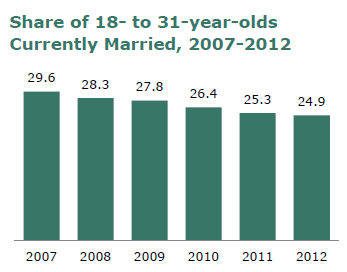Mish's Global Economic Trend Analysis |
| Bernanke Wants 2% Inflation in a Deflationary World; Who Pays the Price? Posted: 04 Aug 2013 05:55 PM PDT PEW Social Trends research shows a Record 21.6 Million Young Adults Live in Their Parents' Home Here are some clips from the fascinating PEW study.  In 2012, 36% of the nation's young adults ages 18 to 31 the so-called Millennial generation—were living in their parents' home, according to a new Pew Research Center analysis of U.S. Census Bureau data. This is the highest share in at least four decades and represents a slow but steady increase over the 32% of their same-aged counterparts who were living at home prior to the Great Recession in 2007 and the 34% doing so when it officially ended in 2009. A record total of 21.6 million Millennials lived in their parents' home in 2012, up from 18.5 million of their same aged counterparts in 2007. Of these, at least a third and perhaps as many as half are college students. The steady rise in the share of young adults who live in their parents' home appears to be driven by a combination of economic, educational and cultural factors. Among them:
Percent of Married Millennial Declines  Long-Term Changes in Young Adult Living Arrangements  Household Formation  Married Residing in Own Household Plummets  Since 1968, age at first marriage has increased by nearly six years for both men and women. Consequently, the share of young adults who are married and residing in their own household has plummeted since 1968. In 2012, only 23% of Millennials were married and residing on their own as household head or spouse, a precipitous decline compared with 1968 when 56% of 18- to 31-year-olds were married and on their own. End PEW Fed Policies Exacerbate Trend Bernanke wants 2% inflation in a deflationary world. Wages have not kept up with inflation as Fed policies exacerbate the trends. The result is apparent. Everyone pays the price, but especially Young adults who cannot afford to get married, and they certainly cannot afford a house. The Fed wants home prices up to help out the banks, but what about the new household formation? And what about student loans and the ability to pay those loans back? And think about how cheap money allows corporations to borrow money for next to nothing to buy technology to replace humans with hardware and software robots. Trends noted by PEW and predicted in this corner at least six years ago are structural long-lasting trends. Those expecting a huge pickup in inflation, a spike in US GDP, or a big boom in housing based on misguided perceptions of "pent-up housing demand", fail to understand how Fed boom-bust and bank-bailout policies preclude such outcomes. Mike "Mish" Shedlock http://globaleconomicanalysis.blogspot.com |
| Posted: 04 Aug 2013 04:15 PM PDT Is the advertising pie growing, shrinking, or simply being redistributed? Let's start with a look at PEW Center research that shows News magazines hit by big drop in ad pages. In a difficult advertising environment for the magazine industry overall, newly-released numbers from the Association of Magazine Media (MPA) show the nation's news magazines being hit particularly hard.Google Take Home Half of Mobile Internet Ads eMarketer reports Google Takes Home Half of Worldwide Mobile Internet Ad Revenues. Google earned more than half of the $8.8 billion advertisers worldwide spent on mobile internet ads last year, helping propel the company to take in nearly one-third of all digital ad dollars spent globally, according to eMarketer's first-ever figures on worldwide digital and mobile advertising revenues at major internet companies. Cannibalization of Ad Market My friend "BC" who sent the links surmises .... "The decline in magazine ad revenues is approximately the same as the increase in Internet and mobile/social media ads; therefore, the net increase in ads is a wash, i.e., cannibalization of the advertising market. Companies earning their revenues from ads will now be in a zero-sum competition for no growth of, and later a falling number of, ad dollars hereafter." Mike "Mish" Shedlock http://globaleconomicanalysis.blogspot.com |
| You are subscribed to email updates from Mish's Global Economic Trend Analysis To stop receiving these emails, you may unsubscribe now. | Email delivery powered by Google |
| Google Inc., 20 West Kinzie, Chicago IL USA 60610 | |


No comments:
Post a Comment